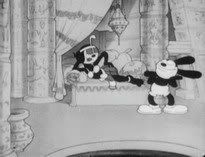I Castelli Animati 2008 - Part Two
Well, they say better late than never, so there you are: as promised, the second and last part of my adventures in Genzano!
One of the main events at the festival was the meeting with some of the veterans of Italian animation, namely Giulio Cingoli, Paolo Di Girolamo, Gibba, Giorgio Castrovillari, and Stelio Passacantando.
Gibba was another one of the guests who didn't come to the festival. Too bad, because not only it would have been nice to meet him in person, but also his films were not screened due to his absence. I would have loved to watch his masterpiece "L'Ultimo Sciuscià" on a big screen!
Luckily all of the other scheduled shorts were screened, including the Castrovillari-Gibba co-production "Il Merlo", a couple of short films by Stelio Passacantando made with animations by grade school children, a handful of Giulio Cingoli productions, including animated commercials, psychedelic segments from live action movies and a narration of the Italian unification in "La Lunga Calza Verde", and Di Girolamo (one of a few European artists who were offered a contract at the Disney studios in California after WWII) presented some of the works of his animation school students.
Lots of interesting exchanges with the artists themselves followed, including a lively argument involving Passacantando and his relationship with the Italian ASIFA.
Among the events at the festival, there were also the presentations of some books: "Il Cinema di Animazione Italiano Oggi" by Sabrina Perucca offers a view on the current state of Italian animation, and followed the screenings mentioned above, offering a link between the past and the future of animation in Italy.
 This was followed by the presentation of the book "Capelli Lunghi", a comic book adaptation of a script by the legendary Italian director Mario Monicelli for an unrealized movie, written in the late Sixties, and revolving around the social revolution taking place at the time.
This was followed by the presentation of the book "Capelli Lunghi", a comic book adaptation of a script by the legendary Italian director Mario Monicelli for an unrealized movie, written in the late Sixties, and revolving around the social revolution taking place at the time.Another featured book was "Viaggi nell'Animazione" by film historian Matilde Tortora. Including essays and interviews with, among the others, Bruno Bozzetto, John Canemaker and Michel Ocelot, the book follows the entire history of animation, from the beginnings to the more recent applications of artificial intelligence and computer technologies to create virtual worlds. It is dedicated to the memory of Simona Gesmundo, who was among the first ones to study the possible uses of artificial intelligence applied to filmmaking and animation, and her name has also been given to an international animation award (http://www.premiosimonagesmundo.com/index.html).
 The last event I could attend was Saturday night's award ceremony. The final winner was Dennis Tupicoff's "Chainsaw", which to me still remains a questionable choice. Sure, it is an interesting film, to say the least: a flow of several different stories connected with an almost stream-of-consciousness sensibility, mixing fact and fiction, including chainsaws, love triangles and bullfighting. I still don't think it deserved the honor of the first prize though, among many other interesting nominees. Gladly one of the films that I really loved, the NFBC-produced "Le Noeud Cravate" by Jean-Francoise Levesque, received an award, the Fabrizio Bellocchio Award for Social Content. Mixing stop motion puppet animation and 2D animation, the film is a metaphorical narration of growing up and facing for the first time the responsibilities of a job. It was a visually great short, and it offered a very touching yet entertaining interpretation of work life, alienation and following ambitions.
The last event I could attend was Saturday night's award ceremony. The final winner was Dennis Tupicoff's "Chainsaw", which to me still remains a questionable choice. Sure, it is an interesting film, to say the least: a flow of several different stories connected with an almost stream-of-consciousness sensibility, mixing fact and fiction, including chainsaws, love triangles and bullfighting. I still don't think it deserved the honor of the first prize though, among many other interesting nominees. Gladly one of the films that I really loved, the NFBC-produced "Le Noeud Cravate" by Jean-Francoise Levesque, received an award, the Fabrizio Bellocchio Award for Social Content. Mixing stop motion puppet animation and 2D animation, the film is a metaphorical narration of growing up and facing for the first time the responsibilities of a job. It was a visually great short, and it offered a very touching yet entertaining interpretation of work life, alienation and following ambitions. Among the other award winners were "The Bridge" by Vincent Bierrewaerts, another stop-motion film which I think absolutely deserved a prize, and the amazing production "Muto" by Italian artist Blu, entirely composed of animation made through graffiti paintings on public walls. It really has to be seen to be believed, and I can't help but admire the incredible work behind this short film.
Among the other award winners were "The Bridge" by Vincent Bierrewaerts, another stop-motion film which I think absolutely deserved a prize, and the amazing production "Muto" by Italian artist Blu, entirely composed of animation made through graffiti paintings on public walls. It really has to be seen to be believed, and I can't help but admire the incredible work behind this short film.Well, that' all for now! Stay tooned for more posts by yours truly, finally back on the blogging scene!
Brought to you by
mmm...donuts
















